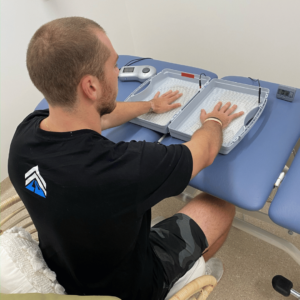
What is Iontophoresis?
Iontophoresis is used for the treatment of hyperhidrosis (excessive sweating) in focused areas such as the feet and hands. Some iontophoresis devices can treat the axilla area; however, this is less effective than treating the hands and feet.
How does Iontophoresis work in hyperhidrosis?
- Ions produced by iontophoresis might physically block the sweat ducks located in the stratum corneum.
- The electrical current produced by the outside source (ionto machine) might disrupt the normal sympathetic nerve transmission
- The accumulation of hydrogen ions causes the pH in the sweat glands to drop
What am I to expect during a treatment?
For the palms, each hand is placed in a tray that contains electrodes. One side of the tray contains room temperature tap water and one side contains a prescription medication called Glycopyrrolate. Any small cuts, abrasions are to have Vaseline applied to prevent any discomfort or localized inflammation.
The machine is turned on and dialed to a certain level to pass the current through the water between the electrodes. At first, the current is low to asses for tolerance, gradually increasing to the therapeutic setting.
Depending if we are treating both the hands and feet, the treatment in clinic takes between 30-50 minutes. This is to be repeated every 3 days if using water only or every 7 days if using a prescribed medicated solution. Every patient sweats differently and has different triggers so it is recommended that you have a series of practitioner assisted treatments here in clinic so that the best treatment regime can be prescribed for you.
How effective is Iontophoresis in the treatment of hyperhidrosis of the hands and feet?
Some studies suggest that as many as 80-85% of patients with hyperhidrosis of the hands notice improvement of their symptoms after 2 weeks of treatment.
Who can have Iontophoresis?
Iontophoresis is generally safe for most people. To ensure suitability all patients require an initial consultation with our Nurse Practitioner.
Iontophoresis should not be used by:
- Patients who have metal implants
- Patients with a pacemaker or heart conditions
- Pregnant or breastfeeding women
- Patients who are epileptic or who have a history of seizures

